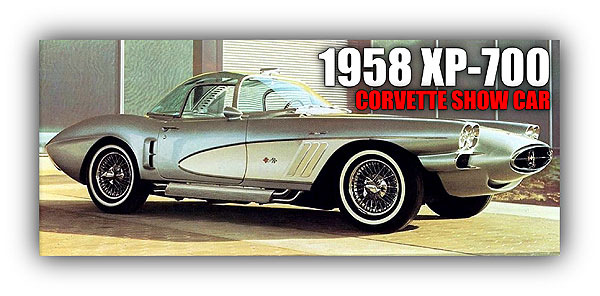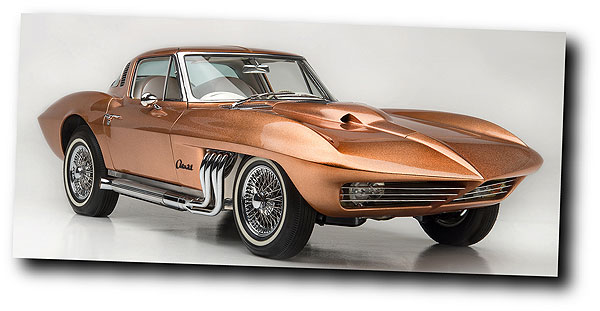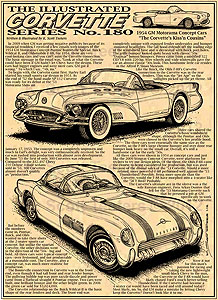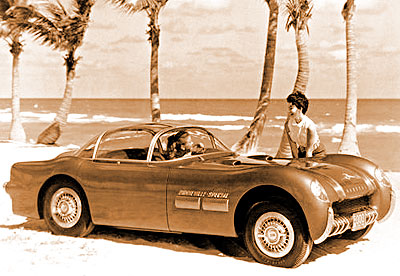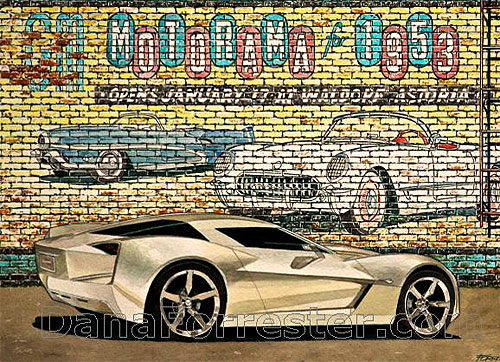Chevy’s 1950s show car custom 1958 Corvette
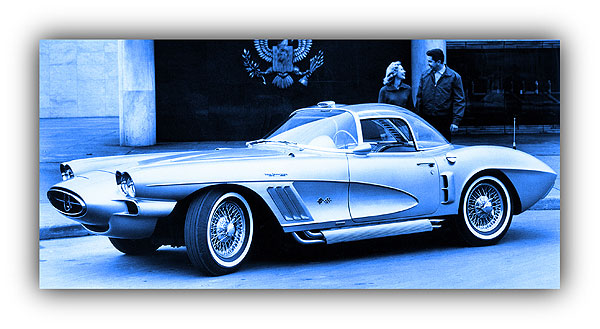 Dateline: 7.15.19 – As seen in the January 2018 issue of Vette Vues (All images GM Archives) – A new era began on December 1, 1958 when William L. “Bill” Mitchell took over the reins of GM Styling from the great Harley Earl. Mitchell started his career as a young illustrator that loved rendering cars, racing cars, and hanging out with the Collier Brothers, the creators of the Sports Car Club of America (SCCA). It was Harley Earl that hired 23-year old Mitchell. From there, Bill learned the business end of the automobile business by working directly for Harley Earl and was in fact, Earl’s handpicked successor.
Dateline: 7.15.19 – As seen in the January 2018 issue of Vette Vues (All images GM Archives) – A new era began on December 1, 1958 when William L. “Bill” Mitchell took over the reins of GM Styling from the great Harley Earl. Mitchell started his career as a young illustrator that loved rendering cars, racing cars, and hanging out with the Collier Brothers, the creators of the Sports Car Club of America (SCCA). It was Harley Earl that hired 23-year old Mitchell. From there, Bill learned the business end of the automobile business by working directly for Harley Earl and was in fact, Earl’s handpicked successor.
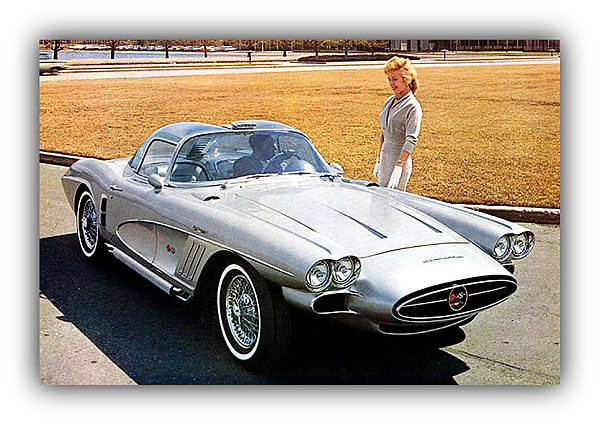 But when Mitchell took over, it was a whole new game. Harley Earl loved rounded shapes and lots of chrome. Bill Mitchell loved slim shapes, with fine, crisp lines. Bill believed that the lines of a car should be “crisp”, like a freshly pressed suit. That’s an important concept to hold on to as we look at the Corvette show cars of Bill Mitchell.
But when Mitchell took over, it was a whole new game. Harley Earl loved rounded shapes and lots of chrome. Bill Mitchell loved slim shapes, with fine, crisp lines. Bill believed that the lines of a car should be “crisp”, like a freshly pressed suit. That’s an important concept to hold on to as we look at the Corvette show cars of Bill Mitchell.
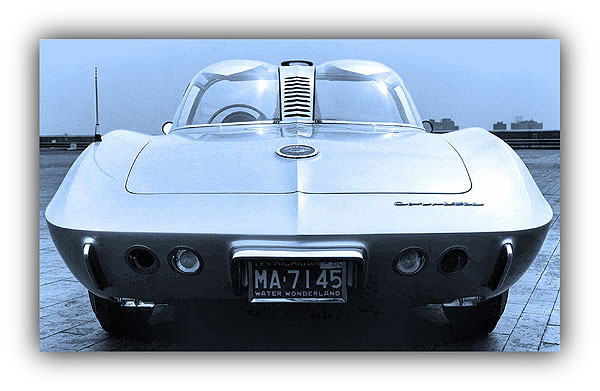
Mitchell’s first indulgence as GM’s Styling V.P. was the acquisition of the 1957 Corvette SS “mule” chassis for a nominal amount (I’ve read anywhere from $1.00 to $100), to use as the foundation of his own racing ambitions. Bill had Larry Shinoda work Peter Brock’s basic Q-Corvette shape into the 1959 Stingray Racer. While Bill was busy racing his Stingray Racer, there often was an accompanying custom Corvette that got a lot of attention.
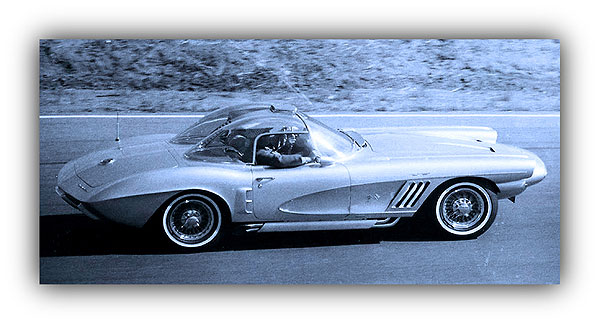 Mitchell had initiated a policy that all dream cars and show cars would be fully functional. No mockups or static shells. Since Bill liked to drive his designs, they should also have plenty of power under the hood. Mitchell liked his cars “loaded for bear!” This was a trend that all Mitchell show cars had. The XP-700 also showed styling elements that would be used on the 1961 to 1964 Corvettes and believe it or not – the 1997 Corvette!
Mitchell had initiated a policy that all dream cars and show cars would be fully functional. No mockups or static shells. Since Bill liked to drive his designs, they should also have plenty of power under the hood. Mitchell liked his cars “loaded for bear!” This was a trend that all Mitchell show cars had. The XP-700 also showed styling elements that would be used on the 1961 to 1964 Corvettes and believe it or not – the 1997 Corvette!
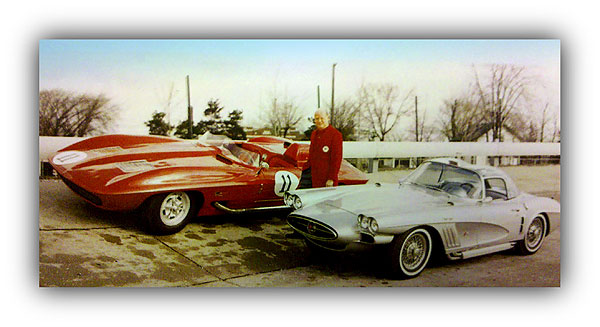 The XP-700 was built on a 1958 283 Fuelie Corvette. In 1950s excess style, everything is “bigger and better”. The front was pure “custom car design” with an elongated, elliptical nose and a scoop under it. Mitchell wanted to break away from the Earl driven, big toothy grille, towards something slim and lightweight. The now-classic Dayton Knock-Off Wire Wheels were part of the effort to make the car look lighter. The Lucas spotlight headlights are moved forward and also had scoops under them. The recessed hood vents showed up on the 1963 Corvette, but with fake grille inserts, and the 1964 Corvette, sans the grilles. The front fender scoops were shorter versions of the production 1956-1957 fender scoops.
The XP-700 was built on a 1958 283 Fuelie Corvette. In 1950s excess style, everything is “bigger and better”. The front was pure “custom car design” with an elongated, elliptical nose and a scoop under it. Mitchell wanted to break away from the Earl driven, big toothy grille, towards something slim and lightweight. The now-classic Dayton Knock-Off Wire Wheels were part of the effort to make the car look lighter. The Lucas spotlight headlights are moved forward and also had scoops under them. The recessed hood vents showed up on the 1963 Corvette, but with fake grille inserts, and the 1964 Corvette, sans the grilles. The front fender scoops were shorter versions of the production 1956-1957 fender scoops.
Show cars have to have plenty of flash and sparkle. The 283 Fuel Injected engine was festooned with lots of chrome and black crackle-finished parts. Today, these kinds of parts are easily available through aftermarket Corvette parts companies, but in 1959, this kind of finish was spectacular. Mitchell loved loud side-pipes; consequently most of his Corvette show-cars had them. Looking more like a custom car setup, the side pipes are interesting, but were a little too short, looking like add-ons, as do the scoops behind the doors.
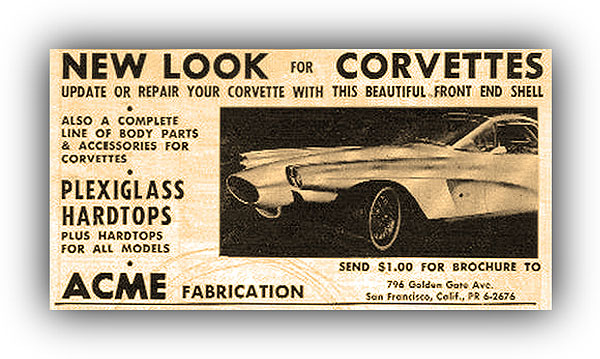
The transparent, bubble top idea was a hold over from the “Jet Age” years of auto styling. To help reduce solar heat, panels of vacuum-deposited aluminum film was placed on the inside of the double-bubble, over the driver and passenger. Between the two bubbles was a metal strip with a periscope rear-view mirror on the top and towards the back cooling vents. The entire top looked like a prop from a 1950s Sci-Fi space movie or something from The Jetson’s animated TV cartoon series. A “transparent roof” option wouldn’t be available until 1978, after years of experimentation with UV Light-blocking transparent films. A toned down version of the twin bubble top roof shape finally arrived in 1997 with the all-new C5.
There were two versions of the tail section. The original version was very short. Then in October 1959 the tail was lengthened, looking more like the production 1961-1962 Corvette. A body crease leads off the tops of the wheel openings and wraps around the back. Below the back edge, the license plate was mounted deep in the center. Now Corvette classic “dual round taillights” flank both sides of the license plate and vertical bumpers were at the corners. The basic shape, with horizontal bumpers, was put into production for 1961 and 1962, and set the design for the back end of the 1963-1967 Sting Ray convertibles.
The interior had features that became standard in 1961, such as the parking-light warning light, dual sun visors, windshield washers, and interior courtesy lights. Yes, early Corvettes had spartan interior amenities. Features that didn’t go into production were the stainless steel foot well grates, the periscope rear view mirror (a primitive version of modern rear-view video monitors), an experimental overdrive unit (tall highway cruising gears are now built into basic transmissions, typically as 5th or 6th gear), and a dash-mounted chronometer (a basic feature that’s now part of the Corvette’s GPS and Performance Data Video Recorder information system). Many of the “gee wiz!” special features of factory show cars from long ago are now either standard production features or special options.
The XP-700 was the first of the street-worthy Corvette show cars. Silver and red were Mitchell’s favorite colors to use on most of the show car Corvettes. The XP-700 wore both colors in its early years. Unlike today’s show cars, Mitchell actually drove many of his show cars to and from work – even the Stingray Racer! From the days of Alfred P. Slone, GM has always had a tight corporate structure, and when Bill Mitchell was rising through the ranks, everything at the corporate level was blue and gray suits. Mitchell was definitely a corporate “Rebel With An Attitude” and was well known for his bright-colored, flamboyant suits.
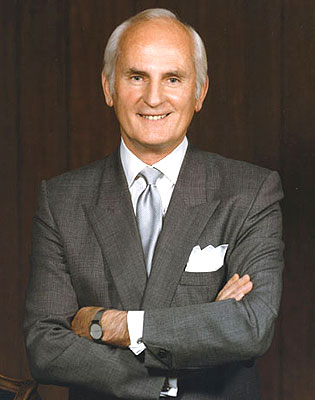
As Chuck “The Chrome Cobra” Jordan (Chief of Styling from 1986-to1992) used to say concerning Mitchell, “The man had flare!” Thanks to Mitchell’s “flare” from 1959 to his retirement in 1977, Corvette fans were treated to a steady flow of exciting Corvette show cars. – Scott


